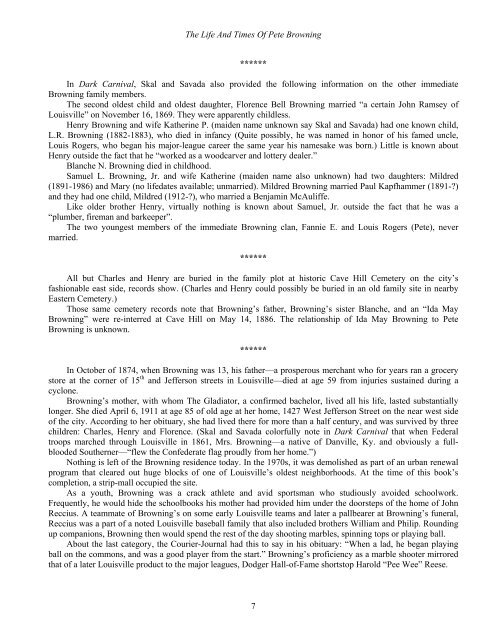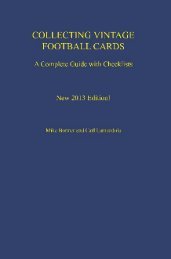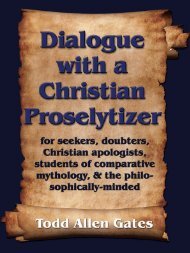AMERICAN GLADIATOR: The Life And Times Of ... - The Book Locker
AMERICAN GLADIATOR: The Life And Times Of ... - The Book Locker
AMERICAN GLADIATOR: The Life And Times Of ... - The Book Locker
Create successful ePaper yourself
Turn your PDF publications into a flip-book with our unique Google optimized e-Paper software.
<strong>The</strong> <strong>Life</strong> <strong>And</strong> <strong>Times</strong> <strong>Of</strong> Pete Browning<br />
******<br />
In Dark Carnival, Skal and Savada also provided the following information on the other immediate<br />
Browning family members.<br />
<strong>The</strong> second oldest child and oldest daughter, Florence Bell Browning married “a certain John Ramsey of<br />
Louisville” on November 16, 1869. <strong>The</strong>y were apparently childless.<br />
Henry Browning and wife Katherine P. (maiden name unknown say Skal and Savada) had one known child,<br />
L.R. Browning (1882-1883), who died in infancy (Quite possibly, he was named in honor of his famed uncle,<br />
Louis Rogers, who began his major-league career the same year his namesake was born.) Little is known about<br />
Henry outside the fact that he “worked as a woodcarver and lottery dealer.”<br />
Blanche N. Browning died in childhood.<br />
Samuel L. Browning, Jr. and wife Katherine (maiden name also unknown) had two daughters: Mildred<br />
(1891-1986) and Mary (no lifedates available; unmarried). Mildred Browning married Paul Kapfhammer (1891-?)<br />
and they had one child, Mildred (1912-?), who married a Benjamin McAuliffe.<br />
Like older brother Henry, virtually nothing is known about Samuel, Jr. outside the fact that he was a<br />
“plumber, fireman and barkeeper”.<br />
<strong>The</strong> two youngest members of the immediate Browning clan, Fannie E. and Louis Rogers (Pete), never<br />
married.<br />
******<br />
All but Charles and Henry are buried in the family plot at historic Cave Hill Cemetery on the city’s<br />
fashionable east side, records show. (Charles and Henry could possibly be buried in an old family site in nearby<br />
Eastern Cemetery.)<br />
Those same cemetery records note that Browning’s father, Browning’s sister Blanche, and an “Ida May<br />
Browning” were re-interred at Cave Hill on May 14, 1886. <strong>The</strong> relationship of Ida May Browning to Pete<br />
Browning is unknown.<br />
******<br />
In October of 1874, when Browning was 13, his father—a prosperous merchant who for years ran a grocery<br />
store at the corner of 15 th and Jefferson streets in Louisville—died at age 59 from injuries sustained during a<br />
cyclone.<br />
Browning’s mother, with whom <strong>The</strong> Gladiator, a confirmed bachelor, lived all his life, lasted substantially<br />
longer. She died April 6, 1911 at age 85 of old age at her home, 1427 West Jefferson Street on the near west side<br />
of the city. According to her obituary, she had lived there for more than a half century, and was survived by three<br />
children: Charles, Henry and Florence. (Skal and Savada colorfully note in Dark Carnival that when Federal<br />
troops marched through Louisville in 1861, Mrs. Browning—a native of Danville, Ky. and obviously a fullblooded<br />
Southerner—“flew the Confederate flag proudly from her home.”)<br />
Nothing is left of the Browning residence today. In the 1970s, it was demolished as part of an urban renewal<br />
program that cleared out huge blocks of one of Louisville’s oldest neighborhoods. At the time of this book’s<br />
completion, a strip-mall occupied the site.<br />
As a youth, Browning was a crack athlete and avid sportsman who studiously avoided schoolwork.<br />
Frequently, he would hide the schoolbooks his mother had provided him under the doorsteps of the home of John<br />
Reccius. A teammate of Browning’s on some early Louisville teams and later a pallbearer at Browning’s funeral,<br />
Reccius was a part of a noted Louisville baseball family that also included brothers William and Philip. Rounding<br />
up companions, Browning then would spend the rest of the day shooting marbles, spinning tops or playing ball.<br />
About the last category, the Courier-Journal had this to say in his obituary: “When a lad, he began playing<br />
ball on the commons, and was a good player from the start.” Browning’s proficiency as a marble shooter mirrored<br />
that of a later Louisville product to the major leagues, Dodger Hall-of-Fame shortstop Harold “Pee Wee” Reese.<br />
7
















